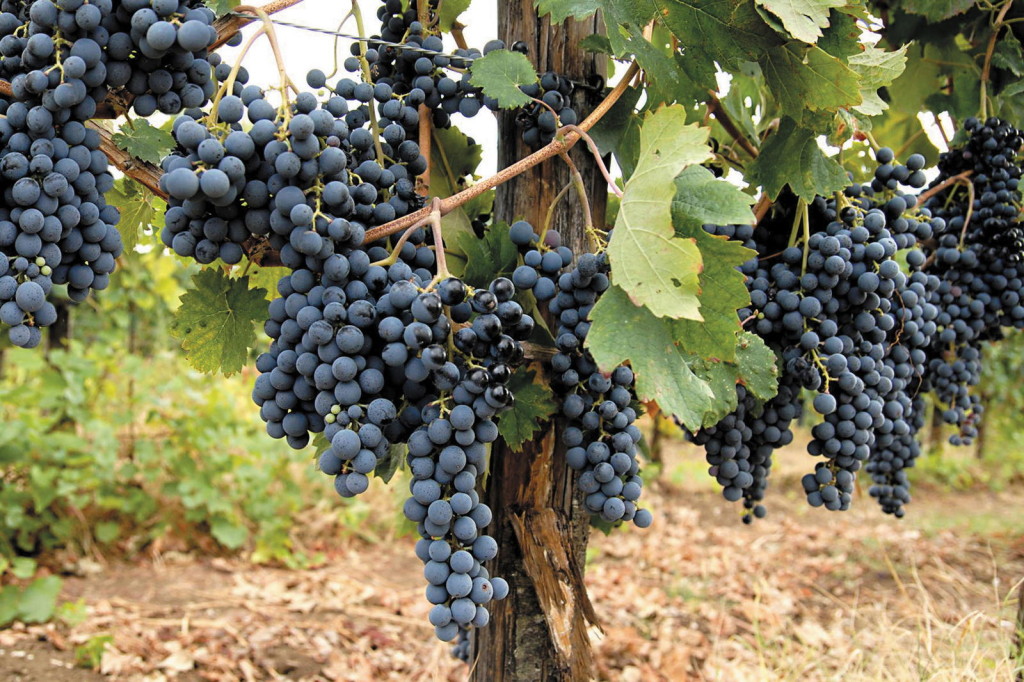On the way into Roccaromana we were accompanied by an agronomist, and so I took the opportunity to ask about the local wines. In addition to the well-known Falerno, made between the mountains and the sea, and Falanghina, on the inland side of the mountains toward Benevento, there is a little-known local grape varietal that grows only in this area, Casavecchia. So called because it is said to be derived from a single vine growing next to an old house ("casa vecchia") which survived the phylloxera epidemic of the early twentieth century, this grape is harvested late, in the middle of October. It is used to produce Casavecchia di Pontelatone, a red wine officially recognised as a DOC wine in 2011. Fermented at a controlled temperature in steel vats, the wine is aged for twelve months in new oak barrels before being bottled and aged further. It is a long-lived wine that can be aged for several years.
 |
| Casavecchia grapes |
Others identify Casavecchia with Trebulanum, a wine drunk by Roman legionaries, mentioned by Pliny the Elder in book XIV of his Naturalis Historia.
But before we leave the Ager Falernus, Falerno country, too far behind, let us take a look at the ancient Roman wine Falernum.
The Falerno we know today is not the same as the wine known as Falernum, produced in the days of Ancient Rome, when it was one of the most prestigious of wines, and considered particularly suitable for aging: ancient Roman Falernum wine was said to need at least 10 years to mature, and be at its best after 15 or even 20 years. Cicerone recommended waiting at least 50 years to drink it, and in fact Pliny the Elder reports that Falernian wine from the renowned Opimian vintage of 121 B.C. was served at a banquet held in 60 B.C. in honour of Julius Caesar's conquests in Spain. Petronius describes the serving of a Falernian wine a hundred years old in his Satyricon:
Statim allatae sunt amphorae vitreae diligenter gypsatae, quarum in cervicibus pittacia erant affixa cum hoc titulo: “Falernum Opimianum annorum centum.” | Dum titulos perlegimus, complosit Trimalchio manus et “Eheu” inquit “ergo diutius vivit | vinum quam homuncio. Quare tangomenas faciamus. | Vinum vita est!"
(Just then some glass jars carefully fastened with gypsum were brought on, with labels tied to their necks, inscribed, “Falernian of Opimius’s vintage, 100 years in bottle.” As we were poring over the tickets Trimalchio clapped his hands and cried, “Ah me, so wine lives longer than miserable man. So let us be merry. Wine is life!")
The prestige of Falernian wine in ancient Rome is confirmed by an inscription on the wall of a tavern in Pompeii reading:
But the Romans' favourite tipple was quite different from the wine we know today: in ancient Roman times wine was a concentrated, highly alcoholic beverage; according to Pliny the Elder, Falernum was "the only wine that takes light when a flame is applied to it". Considering that a beverage must contain at least 40% alcohol to catch fire, we may forgive the ancient Romans for taking their wine diluted with water, though we may not agree with their preference for warm water, or, in some cases, seawater!
The Romans were particularly interested in experimenting with the aromas of wine, adding herbs and spices to produce something like our present-day vermouth or storing wine in resin-coated containers to produce something similar to modern Greek retsina. They even stored amphoras of wine in a fumarium or smoke chamber to add smokiness to the flavour!
Only upper-class patricians drunk actual wine; the lower classes, slaves and soldiery were served posca, a watered-down sour wine (on its way to turning into vinegar) or, even worse, a beverage called lura, which was made by soaking grape skins that had already been pressed twice in water for a day and then pressing them a third time. Soldiers' rations included approximately one litre of posca a day.
The Romans prescribed wine as a cure for mental disorders such as depression and memory loss, and for a whole range of bodily ailments ranging from constipation to diarrhea, from snakebite to vertigo! Wine was used as an antiseptic for treating wounds and as an anesthetic during surgery. But the Romans also recognised the dangers of drinking too much wine, which could lead to madness, "provoking fury in the soul and leading to quarrels", according to Seneca the Elder. This ambivalent attitude towards wine is perfectly summarised in the epitaph of Tiberious Claudius Secundus:
balnea vina Venus
corrumpunt corpora
nostra se<d> vitam faciunt
balnea vina Venus
"Baths, wine, and sex corrupt our bodies, but baths, wine, and sex make life worth living."



Enjoying the blog ... Tiberius Cladius ... had his priorities straight! i love the little stories like this.
ReplyDelete